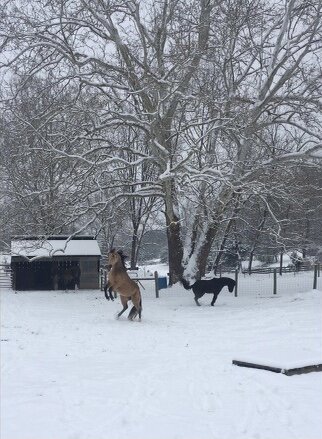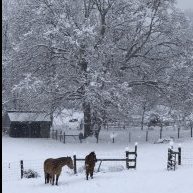-
Posts
988 -
Joined
-
Last visited
Content Type
Profiles
Blogs
Forums
American Weather
Media Demo
Store
Gallery
Posts posted by WesternFringe
-
-
13 hours ago, stormy said:
You mentioned Swoope. Do you by any chance work at VDOT?
No, but I am only a couple of miles from that VDOT location.
Car thermometer said 15 to 18 degrees this morning on my commute. Radio was saying 19 degrees.
-
Craigsville and Hot Springs had a trace otg this morning out this way. Flurries here at work (Swoope) around 8:00am.
-
 1
1
-
-
Had ice on the car for the first time this morning.
-
 4
4
-
-
On 9/29/2023 at 1:18 PM, SnowenOutThere said:
Staunton (within Augusta County) has education rates similar to Prince William, Stafford, King George, Richmond area, etc. Here is a newer, interactive map:
https://statisticalatlas.com/state/Virginia/Educational-Attainment#data-map/county
-
10 hours ago, pazzo83 said:
my dude - i spent my teenage years in Staunton (in the city). I know it's not completely universal in Augusta Co, but let's be real here.
Real about what?- that many people who live in cities stereotype rural populations as dumb and backwards? I have lived in the valley for nearly 30 years and have met many smart, thoughtful people and seen the arts and music scene thrive. There are doctors, lawyers, professors, engineers, meteorologists, etc that live here just like in urban areas. Sometimes stereotypes are just that.
-
 4
4
-
 1
1
-
-
17 hours ago, pazzo83 said:
lol keep this shit in Augusta County - it isn't needed or wanted here.
No need to disparage my county bc of one man. There are plenty of ‘that shit’ in cities, too.

-
19 hours ago, Stormchaserchuck1 said:
Yeah, everyone knows I'm banned from PR.
What did you do in Puerto Rico that was so bad?
-
 2
2
-
-
-
Sleet mixing in with the rain here in Augusta county northwest of Staunton. Car thermometer says 38°

-
 1
1
-
-
74°. About 20 mile an hour winds, but just had a gust to 45. North west of Staunton.
-
47 minutes ago, Eskimo Joe said:
Woke up at 6am it was 32 degrees. Left at 7am and the temp already was up to 36. Goes to show you how strong the sun angle is this time of year.
Yeah, crazy temp swings this time of year. NWS has a frost watch for Friday night and Saturday it rises to 72
-
4 hours ago, WxUSAF said:
Remember when this month was going to be cooler than normal?

Had frost in the morning and another warning from lwx tonight here in Augusta County, but other than these two evenings, it has been about normal to a little cold this month
-
On 3/21/2023 at 1:53 PM, Terpeast said:
Safe to say he's not gonna take the bait.
It was not really bait as much as it was a comeuppance. He talked a lot of trash about not getting any snow in March and specifically mentioned me to rub it in, one of the only posters on here that just had a 12hr+ snowstorm. He talked a lot of shit and when I called him on it, he disappeared and ran away. He deserved my response and the fact he didn’t respond is telling.
-
On 3/19/2023 at 6:34 PM, IronTy said:
Cost is measured in snow on the ground! Basically it's free!
No response to my post responding to your failed attempt at calling me out? Lol
-
5 hours ago, IronTy said:Lmao, I just got home from vacation. Was expecting at least 10" of snow on the ground. Instead I got 50F+ and sunny and my viburnums are about to break into song. Sorry [mention=15338]WesternFringe[/mention], there's always next year. Even a 4th grader coulda figured out that we weren't getting any snow this march. I guess there's always the hope for a late April snowstorm? Cows could come home on their own too.
It snowed all day here starting at 10:00 am until sundown and then more overnight on 3/12. It was awesome!! I spent most of the day outside. Went on a Jebride on my atv. Sledded with the kids. Had a fire going in the wood stove. Had about 4” fall that day and overnight, although the roads didn’t get too bad because of ground temps. Had some time off of school for the kids and my wife and I (we are teachers) the next day, which was much needed. I posted pics in the morning that day in the observation thread.
Sorry you had nothing in your area and saw no snow when you got home. Nice try at rubbing it in @IronTy, but you picked the wrong guy and failed! LolI invited you out to the highlands (elevation is cool) but you never showed up! Lolol

-
 1
1
-
 1
1
-
-
Is it a bad sign for snow prospects when you can't tell the difference between the long range thread and the futility thread? lol
-
 1
1
-
-
1 hour ago, psuhoffman said:
I said for us. 2021 ended up much below normal snow in DC and Balt despite extreme blocking for about 6 weeks in prime climo. That is definitely not producing.
I received a few inches above climo that winter, so the blocking helped at least some of us in this sub.
-
28° and flurries on my way home from my second job here northwest of Staunton
-
 3
3
-
-
35 degrees and flurries intermittent all day here NW of Staunton.
-
 1
1
-
-
It snowed nearly all day today, from 10:00 to sunset. That was awesome.
-
 4
4
-
-
Went on a Jebride on my atv. Lots fell today and even though there wasn’t a ton of accumulation, it was a beautiful day!

-
 17
17
-
-
30° and snowing here northwest of Staunton. Accumulating only on trees and other elevated surfaces at the moment.
eta: Starting to accumulate on the ground. Will update with pictures as the day progresses.



-
 12
12
-
-
39 minutes ago, RevWarReenactor said:
Albany has actually be hosed this year (relative to average). Bare ground up there most of the time, I had to chase further north. Last two storms were mostly rain. They are due.
My sister lives north if Albany. They didn’t do well early in the season, but are making up for it now and look to end with more snow than climo.
Snowing here in Augusta County right now!
-
 4
4
-
-







November Discobs 2023
in Mid Atlantic
Posted
Low around 22 this morning west of Staunton